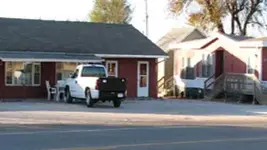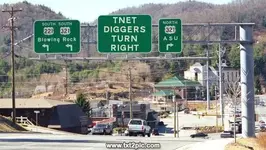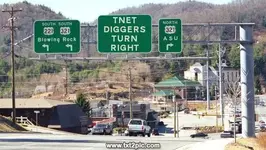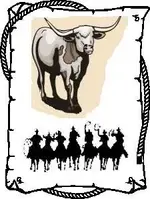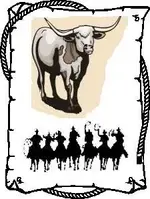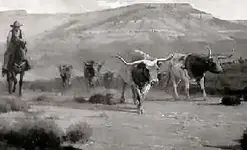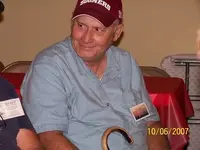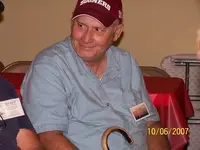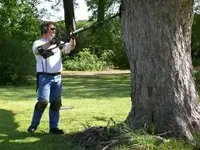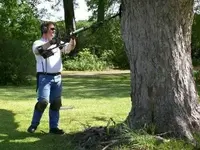Re: The CTH4 hunt will be held September 3,4 & 5th in Caldwell.
Action in Caldwell:
Cowley County Courant, December 29, 1881.
As many of our readers are interested in the cowboy trouble and would like particulars, we clip the following from the Caldwell Post, which is as authentic as any statement of the affair will be.
To begin at the beginning of this affair, one would have to get into the secrets of men’s hearts, so we will only begin at the apparent beginning.
One Jim Talbot, who has been around the city about a month gambling, drinking, bullying, and attempting to bulldoze everyone, was the leader of the party. With Talbot, on the drinking spree during the night, were Jim Martin, Bob Bigtree, Tom Love, Bob Munsen, Dick Eddleman, and George Speers.
Speers did none of the shooting, but was in the act of saddling one of Talbot’s horses when he was shot. Talbot, Martin, Bigtree, Munsen, and Doug Hill were standing, holding their horses near Speers, waiting for him to saddle up.
After the fighting in the city, and Mike Meagher and George Speers were killed, the five outlaws—Jim Talbot, Bob Bigtree, Bob Munsen, Jim Martin, and Doug Hill—rode off to the east of town, across the railroad track. Some one of the citizens fired at and killed a horse from under one of them. He got up behind one of the other men. A party of citizens organized, mounted horses, and started in pursuit.
The outlaws met a man bringing hay to town, with a lead horse in the rear of the wagon. They cut the horse loose and rode it off. At W. F. Campbell’s they got two more horses, those they were riding having been wounded. The party of citizens got sight of them just before they crossed Bluff Creek into the Indian Territory. There were five of the outlaws then, but after they appeared on the prairie beyond, there were only four. They followed at a break-neck pace, both parties keeping up a constant fire for about twelve miles.
The outlaws headed for Deutcher Bros.’ horse ranch on Deer Creek, intending to get fresh horses there, but were so closely pressed by the pursuing party that they could not make change and get away. When they reached the ranch, the citizens were only a few hundred feet away.
The outlaws passed on to the bluff and creek about six hundred feet south of the ranch, dismounted and took to the brush and rocks, firing all the time at the citizens. The citizens finally drove them over the bluff and into a canyon, where there had been a stone dugout. Into this three of the outlaws went, threw up breast-works of stone, got behind them, and would bang away at anyone who showed an inch of his person to their view.
The citizens surrounded the gulch and kept up a constant firing at the fort, but without effect. One of the outlaws took refuge up in a small gulch leading to the west, and was not seen until he fired at W. E. Campbell, who was sliding down the hill on his face to get a commanding point above the fort. The outlaw’s ball took effect in Campbell’s wrist, passing between the two bones. Another ball passed through his clothes six or seven times, and made a small flesh wound on his thigh. This disconcerted the citizens to a certain extent, and it being dark, they could do but little good in fighting. Being up above the outlaws, they were splendid marks for their fire, while the outlaws were in the shadows, so that their position could not be distinguished. Had the fourth man been anywhere else in the gulch the citizens could have taken them in; but his position covered every point that the others were exposed from. In fact, they held the key to the situation. Thirty minutes more daylight would have told the tale for the outlaws; or had Campbell escaped the fire of the villain that shot him, he could have killed the other three in as many minutes as his position commanded the fort in every corner. The two parties were not seventy-five feet apart at any time during the battle, while Campbell’s men were not over twenty-five feet from him when he was shot. Jonny Hall got a bullet through the top of his hat, missing his head about an inch.
Reinforcements arrived at the ranch from town about ten o’clock. Pickets were formed around the gulch, but the outlaws had flown before that time. There were only about fifteen men at the place during the evening fight, and most of them returned to town as soon as Campbell was shot, leaving only six men to guard the gulch and over thirty head of horses. The horses required the attention of at least four men, for they were what the outlaws needed.
The morning round-up revealed the fact that the outlaws had escaped. The entire party, except Sheriff Thralls, Frank Evans, Bob Harrington, Jim Dobson, Sam Swayer, Mr. Freeman, A. Rhodes, another man, and the writer hereof, came to town. About thirty-five came in, leaving the small party to look up the outlaws, inform the camps below to look out for stolen stock, etc. Our party visited two or three camps on Deer Creek and started for home. We met several parties coming out from town, most of them for fun, others for business. They all returned before night.
A party of fifteen was organized by the mayor and started out Sunday evening to guard certain cow camps to see that no horses were stolen from them. The outlaws traveled six or seven miles, possibly ten, Saturday night.
Two freighters were camped on Bullwhacker Creek, about eighteen miles south of this city, Sunday night, when Talbot’s party, five in number this time, rounded them up and took five horses from them. Two of the party were bare-headed, and one had a slight wound in his foot. The outlaws started south.
The freighters came in about two o’clock, when Sheriff Thralls, with a posse, started his pursuit. Another party of freighters passed the outlaws near Pond Creek during the night. The outlaws were going south.
Burdie



 Hey, WSD, what are the statute of limitations for him?
Hey, WSD, what are the statute of limitations for him?





